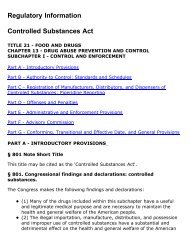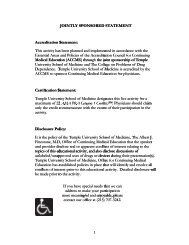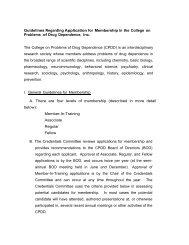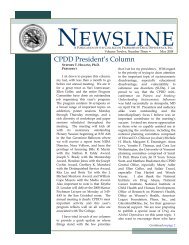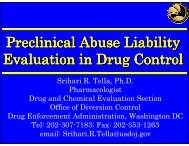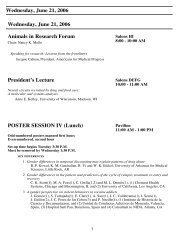CPDD 72nd Annual Meeting • Scottsdale, Arizona - The College on ...
CPDD 72nd Annual Meeting • Scottsdale, Arizona - The College on ...
CPDD 72nd Annual Meeting • Scottsdale, Arizona - The College on ...
Create successful ePaper yourself
Turn your PDF publications into a flip-book with our unique Google optimized e-Paper software.
53<br />
ABUSE DETERRENT ADJUSTED MEASUREMENT MODEL:<br />
ADJUSTING FOR LOCAL PRESCRIPTION OPIOID<br />
AVAILABILITY AND LOCAL USE OF HEROIN.<br />
Ryan A Black, S H Budman, T A Cassidy, S F Butler; Inflexxi<strong>on</strong>, Inc.,<br />
Newt<strong>on</strong>, MA<br />
Aims: Recently, pharmaceutical companies have developed abuse deterrent formulati<strong>on</strong>s<br />
in an effort to address the problem of prescripti<strong>on</strong> opioid abuse in the<br />
US. <str<strong>on</strong>g>The</str<strong>on</strong>g> ADAMM methodology was created to determine the impact of such<br />
formulati<strong>on</strong>s <strong>on</strong> actual levels of abuse. <str<strong>on</strong>g>The</str<strong>on</strong>g> two-part statistical model adjusts levels<br />
of abuse of various prescripti<strong>on</strong> opioids by local availability of each prescripti<strong>on</strong><br />
opioid (“exposure covariate”). Since the extent to which heroin is locally<br />
available has been shown to impact local abuse rates of prescripti<strong>on</strong> opioids,<br />
additi<strong>on</strong> of a sec<strong>on</strong>d covariate that provides an indicati<strong>on</strong> of local use of heroin<br />
is examined. We estimated the relative levels of abuse of several prescripti<strong>on</strong> opioids,<br />
adjusted for both covariates, and examined the effect local use of heroin has<br />
<strong>on</strong> abusing each prescripti<strong>on</strong> opioid.<br />
Methods: Data were analyzed from 3904 patients in substance abuse treatment<br />
representing 208 3-digit client home ZIP codes from 2008 ASI-MV data. A negative<br />
binomial single hurdle model estimated (1) the odds of abusing OxyC<strong>on</strong>tin<br />
relative to comparators (any hydrocod<strong>on</strong>e, Duragesic, Kadian, and Dilaudid) at<br />
least <strong>on</strong>ce in the past 30 days and (2) the rate (# of days/past 30 days) of c<strong>on</strong>tinued<br />
abuse for those reporting any abuse.<br />
Results: Results revealed expected patterns of prescripti<strong>on</strong> opioid abuse levels as<br />
well as effects of prescripti<strong>on</strong> opioid availability and local heroin use <strong>on</strong> abuse of<br />
each opioid product. Local availability was defined as the number of dispensed<br />
morphine equivalent milligrams divided by the populati<strong>on</strong> in each 3-digit ZIP<br />
code, and local heroin use was the number of self-identified heroin users in each<br />
3-digit ZIP code divided by the number of clients in the same ZIP code who<br />
completed the ASI-MV. Inclusi<strong>on</strong> of local use of heroin as a covariate may help<br />
to “even the playing field” when estimating levels of abuse across prescripti<strong>on</strong><br />
opioids.<br />
C<strong>on</strong>clusi<strong>on</strong>s: This model c<strong>on</strong>tinues to show promise as way of evaluating an<br />
ADF’s public health impact.<br />
Financial Support: Inflexxi<strong>on</strong>, Inc.<br />
55<br />
DAT BLOCKER/SERT SUBSTRATES: COMPOUNDS WITH<br />
HYBRID TRANSPORTER ACTIVITY.<br />
Bruce Blough 1 , A Landavazo 1 , J S Partilla 2 , F I Carroll 1 , R B Rothman 2 ; 1 RTI<br />
Internati<strong>on</strong>al, Research Triangle Park, NC, 2 Clinical Psychopharmacology, IRP,<br />
NIDA, Baltimore, MD<br />
Aims: <str<strong>on</strong>g>The</str<strong>on</strong>g> aim was to assess very small molecules as neurotransmitter releasers<br />
and/or uptake inhibitors at the biogenic amine transporters.<br />
Methods: Standard transporter release and uptake inhibiti<strong>on</strong> assays were used to<br />
assess these candidates.<br />
Results: It was found that some small compounds are able to block <strong>on</strong>e (or more)<br />
transporter, while acting as a substrate of another, releasing whatever is stored in<br />
those neur<strong>on</strong>s. For example, 2-(N-cyclopropylamino)-4’-chloro-3’methylpropiophen<strong>on</strong>e<br />
(PAL-820) was found to inhibit DAT with an IC50 of 592 nM while<br />
inducing serot<strong>on</strong>in release with an EC50 of 181 nM. PAL-820 also inhibited<br />
NET with an IC50 of 3583 nM. A series of analogs will be presented.<br />
C<strong>on</strong>clusi<strong>on</strong>s: It has l<strong>on</strong>g been assumed that if a n<strong>on</strong>-selective compound is a<br />
neurotransmitter releaser (substrate) or transport inhibitor at <strong>on</strong>e transporter<br />
such as DAT, it does so at the other biogenic amine transporters. This assumpti<strong>on</strong><br />
has been reinforced by years of study of large molecules as transport blockers,<br />
and a lack of recogniti<strong>on</strong> that small molecule releasers such as amphetamines<br />
are actually substrates of these transporters. This assumpti<strong>on</strong> has been found to<br />
be incorrect. Compounds with hybrid activity exist. This hybrid activity is<br />
unique compared to releasers like amphetamine, which acts as a substrate of multiple<br />
transporters (DAT and NET) or venlafaxine, which acts as a blocker of multiple<br />
transporters (SERT and NET). Such hybrids represent a novel therapeutic<br />
class of compounds.<br />
Financial Support: This work was supported by funding from NIDA<br />
(DA12970).<br />
<str<strong>on</strong>g>CPDD</str<strong>on</strong>g> <str<strong>on</strong>g>72nd</str<strong>on</strong>g> <str<strong>on</strong>g>Annual</str<strong>on</strong>g> <str<strong>on</strong>g>Meeting</str<strong>on</strong>g> <str<strong>on</strong>g>•</str<strong>on</strong>g> <str<strong>on</strong>g>Scottsdale</str<strong>on</strong>g>, <str<strong>on</strong>g>Ariz<strong>on</strong>a</str<strong>on</strong>g><br />
14<br />
54<br />
SEX DIFFERENCES IN THE INFLUENCE OF NEGLECT ON<br />
TOTAL INTRACRANIAL WHITE MATTER IN HIGH-RISK<br />
ADOLESCENTS.<br />
Rebecca Blant<strong>on</strong>, L Mayes, M Potenza, R Sinha; Yale University, New Haven, CT<br />
Aims: Few studies have examined sex differences in brain morphology in adolescents<br />
at-risk for substance abuse. This study examined sex differences in at-risk<br />
adolescents in brain morphometric measures of the amygdala nucleus, total<br />
intracranial (IC) volumes of grey and white matter and measures of trauma.<br />
Relati<strong>on</strong>ships between brain morphometric variables and childhood trauma<br />
questi<strong>on</strong>naire (CTQ) resp<strong>on</strong>ses were also examined.<br />
Methods: At-risk adolescents (26 males; 16 females; ages 14-17 years) from a<br />
l<strong>on</strong>gitudinal cohort of children followed since birth and well characterized <strong>on</strong><br />
prenatal cocaine exposure (PCE) and other psychosocial variables participated in<br />
a single magnetic res<strong>on</strong>ance imaging (MRI) sessi<strong>on</strong>. Total intracranial volumes of<br />
grey and white matter were automatically computed using BrainSuite software<br />
after removal of extracerebral tissue and correcting for possible radio frequency<br />
inhomogeneities. <str<strong>on</strong>g>The</str<strong>on</strong>g> left and right amygdala were traced in the cor<strong>on</strong>al viewing<br />
plane using Multitracer software by <strong>on</strong>e rater blind to gender and other variables.<br />
Results: After co-varying for PCE, an overall main effect of sex was found<br />
between left (F(1,37=14.26, p=.001) and right amygdala volumes<br />
(F(1,37)=5.45, p=.025). However, these effects did not hold after adjusting for<br />
total IC volume. After adjusting for PCE, males but not females showed significant<br />
correlati<strong>on</strong>s between IC white matter volume and CTQ score (r=-.58,<br />
p=.004), emoti<strong>on</strong>al neglect (r=-.54, p=.008), physical neglect (r=-.57, p=.004),<br />
and denial (r=.48, p=.021), resulting in significant differences in the independent<br />
correlati<strong>on</strong>s of IC white matter volume and measures of trauma between male<br />
and females.<br />
C<strong>on</strong>clusi<strong>on</strong>s: <str<strong>on</strong>g>The</str<strong>on</strong>g>se preliminary results suggest significant sex differences in the<br />
relati<strong>on</strong>ship between IC white matter volume during adolescence and measures<br />
of childhood trauma. Further studies using diffusi<strong>on</strong> tensor imaging may be of<br />
benefit in elucidating the specific fiber pathways that may be affected in males<br />
relative to female children at-risk for substance use disorders.<br />
Financial Support: (Supported by P50-DA016556).<br />
56<br />
PERCEPTIONS OF METHAMPHETAMINE/ DRUG USE<br />
AMONG AGENCY PERSONNEL IN SOUTHWEST NATIVE<br />
AMERICAN COMMUNITIES.<br />
M P Bogenschutz 1 , Alyssa A Forcehimes 1 , J M Houck 1 , A M<strong>on</strong>drag<strong>on</strong> 1 , M P<br />
Davis 1 , A Reid 1 , K Foley 2 ; 1 CASAA, University of New Mexico, Albuquerque,<br />
NM, 2 Na’nizhoozhi Center Incorporated, Gallup, NM<br />
Aims: In 2003, the Indian Health Service reported that methamphetamine use<br />
am<strong>on</strong>g Native Americans was three times higher than that of the general populati<strong>on</strong>.<br />
However, little is known about the use and prevalence of methamphetamine<br />
and other drug use in Native American populati<strong>on</strong>s within New Mexico.<br />
Teleph<strong>on</strong>e surveys were c<strong>on</strong>ducted with providers, counselors and law enforcement<br />
pers<strong>on</strong>nel to assess their percepti<strong>on</strong>s of drug use throughout New Mexico<br />
and the Four-Corners area. Here we present preliminary findings of this <strong>on</strong>going<br />
study.<br />
Methods: Treatment providers (n=15), school administrators (n=15), police officers<br />
and correcti<strong>on</strong>al facility officials (n=7) in Native American Communities in<br />
the Southwest were asked to participate in a ph<strong>on</strong>e survey regarding their percepti<strong>on</strong>s<br />
of Native American methamphetamine and other drug use. <str<strong>on</strong>g>The</str<strong>on</strong>g> 15minute<br />
structured questi<strong>on</strong>naire c<strong>on</strong>tained questi<strong>on</strong>s that were both quantitative<br />
and qualitative in nature.<br />
Results: Most resp<strong>on</strong>dents (67.5%) identified alcohol as the number <strong>on</strong>e problem<br />
substance in their communities, followed by marijuana (17.5%), heroin<br />
(5.0%), and methamphetamine (5.0%). Most participants (86.8%) reported that<br />
methamphetamine was a mild or moderate problem in their communities; 13.2%<br />
said that it was a severe problem. <str<strong>on</strong>g>The</str<strong>on</strong>g> number of meth users encountered per<br />
m<strong>on</strong>th ranged widely between participants, with a mean of 13.5(sd 20.6) and<br />
median of 3.0. <str<strong>on</strong>g>The</str<strong>on</strong>g> degree to which participants saw methamphetamine as a problem,<br />
and the number of methamphetamine users they saw per m<strong>on</strong>th, were not<br />
significantly correlated with the rank assigned to methamphetamine as a problem<br />
substance (Spearman ρ = -.143, p = .450; ρ = -.304, p = .068, respectively).<br />
C<strong>on</strong>clusi<strong>on</strong>s: Methamphetamine was perceived as less of a problem than other<br />
substances by most survey resp<strong>on</strong>dents. <str<strong>on</strong>g>The</str<strong>on</strong>g> findings of this survey shed light <strong>on</strong><br />
the geographic distributi<strong>on</strong> of methamphetamine problems in Indian Country,<br />
and will help to focus future efforts in preventi<strong>on</strong> and treatment research.<br />
Financial Support: NIDA CTN



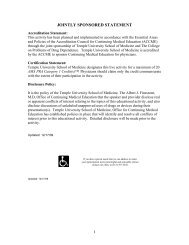
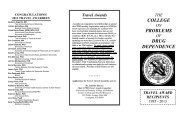
![2013SYMP AND WORKSHOP LIST[web]](https://img.yumpu.com/35325424/1/190x245/2013symp-and-workshop-listweb.jpg?quality=85)
